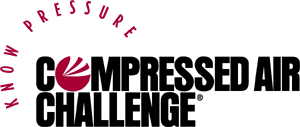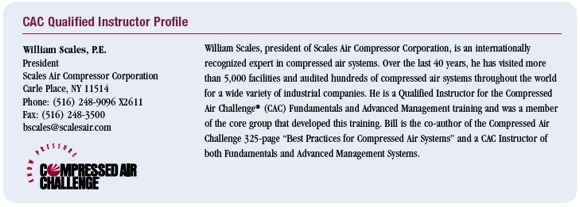Compressed air dryers are important items to consider when evaluating the efficiency of a typical compressed air system. One of the keys to optimal system operation is ensuring the air is only dried to the level required by the actual needs of the facility. “In selecting dryers, always consider the required dewpoint and the initial price compared to total operating costs,” says Bill Scales, co-author of CAC’s Best Practices Manual and a certified Advanced Level instructor, “Higher quality air usually requires additional equipment and can lead to increased capital investment and possibly higher operating costs.”
For example, using standard uncontrolled heatless desiccant dryers may cost 3 to 4 times more than using a similar sized refrigerated dryer. “Significant energy can be saved if the plant is operating desiccant dryers when a properly designed refrigerated dryer installation would provide adequate air treatment. Even if desiccant dryers are needed, many plants that require -40F or better dew point are using the low initial cost heatless dryer technology which is the most expensive to operate,” says Jan Zuercher, Director of Air Systems for Quincy Compressor, and a certified CAC Fundamentals Instructor, “There are more energy efficient desiccant dryer technologies available today that offer excellent payback opportunities.”

Attendees of the Compressed Air Challenge, Fundamentals and Advanced training learn about the types of air dryers and the differing characteristics that affect system performance. The Compressed Air Challenge also has a number of resources available to those who are interested in learning more about compressed air dryers. The following is an excerpt from CAC’s “Improving Compressed Air System Performance: A Sourcebook for Industry”.
Compressed air system performance is typically enhanced by the use of dryers, but since they require added capital and operating costs (including energy), drying should only be performed to the degree that it is needed for the proper functioning of the equipment and the end use.
Single-tower, chemical deliquescent dryers use little energy, but provide a pressure dew point suppression of 15 to 50°F below the dryer inlet temperature, depending on the desiccant selected. They are not suitable for some systems that have high drying needs. The approximate power requirement, including pressure drop through the dryer and any associated filtration, but excluding the cost of replacement desiccant, is approximately 0.2 kW/100 cfm.
Refrigerant-type dryers are the most common and provide a pressure dew point of 35 to 39°F, which is acceptable for many applications. In addition to the pressure drop across the dryer (usually 3 to 5 psid), the energy to run the refrigerant compressor must be considered. Some refrigerant-type dryers have the ability to cycle on and off based on air flow, which may save energy. The power requirement, including the effect of pressure drop through the dryer, is 0.79 kW/100 cfm.
On larger dryers, cylinder head unloading is available (single and two-step) and offers improved part-load performance over conventional refrigerated dryers. Cylinder head unloaders allow discreet steps of control of the refrigerant compressor, just as unloaders allow capacity control of reciprocating air compressors.
Twin-tower, desiccant-type dryers are the most effective in the removal of moisture from the air and typically are rated at a pressure dew point of –40°F. In a pressure-swing regenerative dryer, the purge air requirement can range from 10 to 18 percent of the dryer’s rating, depending on the type of dryer. This energy loss, in addition to the pressure drop across the dryer, must be considered. The heated-type requires less purge air for regeneration, as heaters are used to heat the desiccant bed or the purge air. The heater energy must also be considered against the reduction in the amount of purge air, in addition to the pressure drop. Approximate power requirement, including pressure drop through the dryer, is 2.0 to 3.0 kW/100 cfm. Excellent savings can be gained with these types of dryers, if partially loaded, using dewpoint controls.
Heat-of-compression dryers are regenerative desiccant dryers, which use the heat generated during compression to accomplish desiccant regeneration. One type has a rotating desiccant drum in a single pressure vessel divided into two separate air streams. Most of the air discharged from the air compressor passes through an air aftercooler, where the air is cooled and condensed moisture is separated and drained. The cooled air stream, saturated with moisture, passes through the drying section of the desiccant bed, where it is dried and it exits from the dryer. A portion of the hot air taken directly from the air compressor at its discharge, prior to the aftercooler, flows through the opposite side of the dryer to regenerate the desiccant bed. The hot air, after being used for regeneration, passes through a regeneration cooler before being combined with the main air stream by means of an ejector nozzle before entering the dryer. This means that there is no loss of purge air. Drying and regeneration cycles are continuous as long as the air compressor is in operation.
This type of dryer requires air from the compressor at sufficiently high temperature to accomplish regeneration. For this reason, it is used almost exclusively with centrifugal or lubricant-free rotary screw compressors. There is no reduction of air capacity with this type of dryer, but an entrainment-type nozzle has to be used for the purge air. The twin-tower, heat-of-compression dryer operation is similar to other twin-tower, heat-activated, regenerative desiccant dryers. The difference is that the desiccant in the saturated tower is regenerated by means of the heat of compression in all of the hot air leaving the discharge of the air compressor. The total air flow then passes through the air aftercooler before entering the drying tower. Towers are cycled as for other regenerative desiccant-type dryers. The total power requirement, including pressure drop and compressor operating cost, is approximately 0.8 kW/100 cfm.
Membrane-type dryers can achieve dew points of 40°F but lower dew points to –40°F can be achieved at the expense of additional purge air loss.
Advantages of membrane dryers include:
- Low installation cost
- Can be installed outdoors
- Can be used in hazardous atmospheres
- No moving parts.
Disadvantages of membrane dryers include:
- Limited to low-capacity systems
- High purge air loss (15 to 20 percent) to achieve required pressure dew points
- Membrane may be fouled by oil or other contaminants and a coalescing filter is recommended before the dryer.
The total power requirement, including pressure drop and compressor operating cost is approximately 3 to 4 kW/100 cfm.
Dryer Selection
The selection of a compressed air dryer should be based upon the required pressure dew point and the estimated cost of operation. Where a pressure dew point of less than 35°F is required, a refrigerant-type dryer cannot be used. The required pressure dew point for the application at each point-of-use eliminates certain types of dryers. Because dryer ratings are based upon saturated air at inlet, the geographical location is not a concern. The dryer has a lower load in areas of lower relative humidity, but the pressure dew point is not affected. Typically, the pressure drop through a compressed air dryer is 3 to 5 psi and should be taken into account in system requirements. Compressed air should be dried only where necessary and only to the pressure dew point required.
Maintenance
“Treatment equipment, including automatic drain traps, must be properly maintained to retain top quality results from air dryers and filters.”, says Bill Scales, “Often dryers are subjected to inlet or ambient air temperatures that exceed design specifications and will not produce the desired dewpoint or may even shut down. Sometimes, either water-cooled or air-cooled condensers have not been maintained causing the dryer to fail. There are occasions where the pressure drop across dryers or filters has not been addressed and the compressor discharge pressure has been increased leading to increased energy consumption.”
Dryer Part Load Efficiency
An important item to note when assessing air dryer performance is the part load efficiency of air dryers. Often air dryers are subject to part loaded conditions where the inlet flow, temperature and pressure, result in lower than rated moisture loading. Some types of dryers turn down their energy consumption in relation to this reduced moisture loading to save operating costs. Some assistance in determining the turn down of a refrigerated air dryer can be found in reviewing the CAGI dryer data sheets a sample of which is listed at http://www.cagi.org
Need more information? Try our “Best Practices for Compressed Air Systems”. This 325 page manual is available at our bookstore or visit www.compressedairchallenge.org






